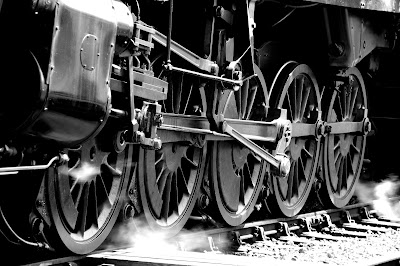Monday, July 22, 2013
Book Notes: God's Adventurer; The Story of Stuart Windsor and The Persecuted Church by Stuart Windsor and Graham Jones
I first met Stuart Windsor many years ago at a Christian Solidarity Worldwide (CSW) event at which Baroness Caroline Cox was telling a profoundly moved Perth audience about her recent stay with the persecuted Christian communities of Nagorno Karabakh. Stuart was quietly manning the bookstall and information stand and signing people up to receive CSW’s regular news and prayer letter. I remember speaking very briefly to him. I met him again recently –he was speaking at a church near us, again about the plight of people persecuted for their faith, and this time I was able to speak to him at greater length. What I hadn’t realised when I met him, was that this genial and ebullient man somewhat self-effacingly hides a remarkable personal history. While when I met him he was running a bookstall, his support of the persecuted church has not been restricted to office work and administration, but has taken him all around the world, to war zones, areas of conflict and through situations of great difficulty and extreme danger. Stuart has now worked with the writer Graham Jones to tell this complete story for the first time, and the result is a powerful, and gripping book which demands an urgent response.
This is not a conventional autobiography, in which the subject examines every aspect of his life; but really is about all the events which combined to make caring for the persecuted church his life calling and great passion - and how that has been outworked over the last half-century. The book begins with one of Stuart’s remarkable fact-finding missions and documents a series of amazing answers to prayer; but this is really only a taster of what is to come. It then details Stuart’s tragic early family life and his childhood and adolescence in the care of Barnardo’s Homes followed by his career in the RAF, military intelligence, and then in the Water Board. Marriage and Children then followed – and all of this is pretty standard biographical stuff. What changed Stuart’s life was his conversion to Christianity when in the services, which led to abandoning the hard-drinking lifestyle he had pursued and finding a spiritual home amongst the Pentecostals. Here he began to explore what purpose God might have for his life. Training and ordination followed, but Stuart was never called to pastor a church, and worked in the film unit of the denomination producing videos of conferences and events. It was when he was asked to join a delegation to persecuted Christians, to film their stories, that he discovered his life’s calling; to stand in solidarity with the suffering church.
The book tells the story of how Stuart began to pursue this cause, and how with notable people like Baroness Cox he was able to publicise the fate of forgotten minorities, such as the beleaguered people of the Nagorno Karabakh enclave to the churches in the West for their prayers, and to politicians for their actions. This led in turn to Stuart’s appointment as head of Christian Solidarity Worldwide, from where he has led campaigns for the rights of the oppressed in Nigeria, India, Pakistan, Saudia Arabia, Eritrea, North Korea, and Sudan.
CSW has specialised in producing first-class research from these areas, which has won the respect of governments, aid agencies, and bodies like the UN. Much of this intelligence gathering has been done at enormous personal risk, and the book quite matter-of-factly tells of being shot at in aircraft, being cut-off in blizzards, having car break-downs in the middle of Africa, confronting dictators, and listening to oppressors in order to gain a balanced view of all the conflicts they report on. All through this are countless incidents when human wisdom and resources are exhausted and the CSW teams have turned to prayer and seen surprising answers.
This is not a demanding read in an academic sense, it is fast –paced and written in popular language. Nevertheless is it a book which lives on in the mind even when the final page has been read and the covers closed, it demands a response because the suffering of the church has if anything escalated in the year or two since it was published. The images firmly lodged in my mind as I put the book back on my shelf include Stuart Windsor praying with friends in Africa for spare car parts so that they could get out of the country, of trucks full of aid heading into Nagorno Karabakh, of the government bombers destroying the villages of Southern Sudan, of Iranian Martyrs bravely standing for Christ under the terror of the Islamic revolution, of the fear of Sharia Law in Nigera, and of the courageous and professional work of CSW exposing these hidden crimes, and being the ‘voice for the voiceless’ – standing alongside the forgotten ones.
Stuart has formally retired from his role at CSW, but the fight for justice for the oppressed continues. I am told that Stuart is still hard at work in his 'retirement'. The CSW website contains details of all their current campaigns, details of current world issues in the area of freedom of religion, and many opportunities to join in the work www.csw.org.uk
Tuesday, July 16, 2013
The Bluebell Railway: Through the Cutting
When I was young, a visit to a steam railway was always a special treat - a great family day out. Trying to capture something of the sight, sound, smell and evocative pathos of the preserved locos on camera was an added enjoyable feature of the day. Of course, in those pre-digital days, every shot had to count, and it could be many weeks before a full film was used up and taken to Boots in the High Street for developing and collecting the next day. There were, naturally, many disappointments at the photo-counter when prints emerged looking blurred, or lacking much colour...
One of the days out I used to enjoy like this was to the Bluebell Railway in Sussex - a particularly fine preserved railway; recreating different eras of the line's one and a half centuries of existence at different points along its eleven mile length.
Unlike "The Watercress Line" in Hampshire which connected to British Rail at Alton, The Bluebell Line was harder to get to, impossible without a car, in fact. As a result, my camera and I went to Ropley far more often than to Sheffield Park.
Originally, of course, The Bluebell Line was part of the national rail network, but was one of many lines "Beeching'd" into submission after WWII. Dr Beeching cannot be held directly responsible for this closure however, as it pre-dated his contentious reign at BR. Since its closure, the volunteers who re-opened a section of it, had long hoped to reconnect it to national rail, at East Grinstead where the tracks had been severed. What lay between Bluebell metals and the town was a major obstacle - The Imberhorne Cutting. In the decades without rail, the local council had used the redundant rail cutting as a landfill site, containing almost 100,000 tons of domestic waste, stores under layers of clay and top-soil. The cutting was completely full.
Decades of fundraising have led to the recent completion of the £11m job of digging out the waste, rebuilding the sides of the cutting and returning the railway to East Grinstead. The staff and volunteers managed this in March 2013.
I haven't been to the Bluebell for years, but have watched their website with interest as they have carried away train load after train load of waste - and rebuilt the railway. It was great, last week, to be able to catch a train from Clapham Junction, and change at East Grinstead for The Bluebell Railway. It was fascinating to be steam hauled across the Imberhorne Viaduct, and into the cutting before winding our way out across the Sussex countryside.
Work is still clearly underway deep down in the cutting. A diesel loco was working all day, taking heavy clay out of the cutting , while teams of engineers continued to construct retaining walls to add strength to the very steeply sided banks.
Having seen it so many times on the screen, it was good to be able to visit and see it for real. The only disappointment was the very limited timetable, which meant that from the train connection it was only possible to stop off at one station. I chose Sheffield Park with the engines sheds and museum but was therefore prevented from exploring Horsted Keynes, probably the finest station on the line and the star of countless TV and film appearances. Connection with London trains before midday would have made the visit even better - but I suppose it was midweek, during school termtime!
Saturday, July 13, 2013
The Bluebell Railway: The Power of the 9F
The British Railways standard class engines, designed and built in the 1950s, were hybrids - seeking to combine the best engineering traditions from each of the railways which had been nationalised by the postwar Labour government. Without shareholders to please, or investors to impress, and without the need to lure passengers from rival networks with glamorous advertising; the "standards" eschewed style in favour of rugged functionality and efficiency. This was never more the case than in the freight powerhouse the "9F", which although sometimes drafted in to run passenger trains like the famous "Pines Express" over the Somerset & Dorset; was primarily designed for carrying great loads of heavy goods. The massive boiler and great outside cylinders bore their weight down upon ten connected driving wheels to deliver the massive tractive effort the 9F produced. The result was a great locomotive.
A delay in departure at Sheffield Park, means a waste of carefully prepared steam. The valves lift and a great roar of steam expands into the afternoon Sussex air.
The fireman works the shovel, building up a good head of steam for the afternoon train North to East Grinstead. With every shovel load, the smoke darkens.
After a delayed start, the 9F eases its coaches northwards from Sheffield Park, with spare steam still billowing from the valves. A five-coach train is effortless for an engines capable of hauling 1000+ ton coal trains. With little more than a few barks from the chimney, the train reaches, 25mph, the speed limit on this line.
Entering the new Bluebell Railway station in East Grinstead, coming off the viaduct which takes the trains high over the town, the 9F shimmers in bright afternoon sun, waiting permission to draw alongside the platform.
At rest, Sheffield Park.
The Bluebell Railway, Fireman and Driver
The BR 9F is a great beast of an engine, which must be both fed and watered.
And handled, with great care, and huge skill.
Job done, tea earned.
Monday, July 08, 2013
Book Notes: This Mighty Scourge: Perspectives on The [American] Civil war by James M. McPherson
"This Mighty Scourge: Perspectives on the Civil War" is a collection of sixteen stand-alone essays by James M. McPherson, many of which have appeared in various journals and publications previously - but have been edited, and collected into one volume by Oxford University Press. Of course, the "Civil War" in question is the American one- a fact which the American cover designer fails to mention in a little flurry of inexcusable ethno-centricity! Despite this, once inside the cover, the reader will discover a fascinating, insightful, well-researched and well-argued series of papers on various aspects of the American Civil War, which ravaged America in the 1860s.
Many civil war histories focus on the minutiae of the various set-piece battles, and on the supposed genius (or otherwise) of the competition between great generals like Grant vs Lee. While the battlefield experience of individual soldiers in this ghastly conflict is stark reading, too much ink has been spilled in detailed military histories, at the expense of the wider social/political/economic landscape of The American Civil War. Thankfully McPherson's interests in these essays very much counterbalances that picture, and while the battlefield is not ignored at all; incidents such as Picketts' infamous charge at Gettysburg are placed within their more useful wider context of Lee's 'war aims' for the Gettysburg campaign. The apparent suicidal nature of that manoeuvre, is explained as an all-out last-ditch attempt to deliver a knock-out blow to the Union Army of the Potomac, as Lee knew that the Confederate War Machine might not sustain the effort for another year - while Northern war-weariness meant that a major loss at that point might mean that Lincoln could fall in favour of a less hawkish commander-in-chief.
The topics covered in this volume are highly varied. Chapter One defends the view that the slavery issue was a central (not sole) cause of the war; against the view of the 'Progressive Historians' for whom economic causes dominate. Chapter Two examines the roles of Harriet Taubman, Harriet Jacobs, the "Underground Railroad" and radical abolitionism as a cause of war. It concludes with a great little summary of the flawed, messianic, violent abolitionism of John Brown. Chapter Three examines the oft-made assertion that the war was primarily "lost by the South" rather than "won" by the North. McPherson dismisses this thesis, by showing that the North was just as divided as the Confederacy ever was. Rather, the South was remarkably united in battle, hugely and remarkably committed to fighting a prolonged bloody war, while enduring great suffering. A question for further research he asks is, "why were so many non-Slave-owning-whites willing to fight and die for the Confederacy?". This is a good question, and it would be interesting to read some more detailed local studies, perhaps accessing the letters, diaries and papers of combatants and their families which analyse their various motivations. I wonder, for instance, if these varied across the Confederacy? Chapter Four looks at the overall military strategy of the South - asking if the Confederacy would have fared better in a more purely defensive war, rather than their invasions of Union States; and concluding against the suggestion.
In Chapter Five, McPherson produces a well-drawn comparison between the Battle of Saratoga in the American War of Independence, and the American Civil War battle of Antietam. In both of these battles west of The Atlantic, interested parties in Europe had decisions to make about which governments to recognise as legitimate, or indeed to militarily assist. Just as the Battle of Saratoga turned the independence battle in favour of the revolutionaries, and prompted foreign recognitions - so the rebels loss of the horrific battle at Antietam made would-be supporters back-off. The Confederacy fought on alone, without foreign recognition and military or financial aid; despite the fact that European mills, rulers and workers cried out for its rich supplies of cotton. Chapter Six examines Robert E. Lee's war aims in the Gettysburg campaign - arguing that his aims were much grander than those he left in his written records. His stated aims included such things as tying-up Grant's armies to prevent them intervening in other theatres, and gaining good sources of food for his hungry troops from Northern farmlands. However, McPherson argues that (as mentioned), Lee saw his Northern incursion as a final opportunity to win the war. McPherson has little time for those who have endowed some form of military sainthood on Robert E Lee. The caricature of Lee as the gentleman soldier, and Grant as the exponent of industrial-scale military butchery owes, in his account, little to fact and much to post-bellum Southern sentimentality. Lee's armies, he points out, suffered almost the highest casualty rates of any General in this war; which given it was one of the worst ever wars for combatant mortality, makes him an appalling General in many ways. Yet, what Lee did know, is that a decisive win at Gettysburg could have brought The Union to the negotiating table, and allowed them all to return home.
Chapter seven changes tack completely as it is an essay about Jesse James, the flamboyant outlaw figure of American history, sometime popularly seen as an American Robin Hood. McPherson has no time for this, but rather interprets James' career as that of a Confederate Guerrilla, who turned his ire and pistols on carpetbaggers and Republicans after the official war had been lost. The post-war theme continues in the eighth chapter when the way in which the war was remembered (especially in the South) is analysed, with special reference to education. Confederate apologists sought to honour their dead, and promote a positive view of the rebellion as a noble crusade for States Rights against Federal Dictatorship, rather than as a squalid pro-slavery movement to perpetuate the immoral trade in human souls. The key battle was for educational textbooks, and the minds of the young. Just as whites were re-asserting their control of the South and establishing the crushing system of segregation; so they seized the curriculum and instilled the myth of "The Lost Cause" in succeeding generations.
Chapter Nine is the only chapter which looks at the roles and skills of the main generals in the war. He attempts something of a rehabilitation of the reputation of Ulysses S Grant; and credits William T. Sherman as being the father of modern high-speed, manoeuvrable warfare, slicing through the Confederacy and maiming its capacity to wage war. The question of whether the Union waged "Total-War" on the south is addressed in the tenth chapter. Total-War is defined as the all-out, no-holds-barred attempt to smash every aspect of the enemy; without respect to whether the victims are combatants or civilians. WWII's blitz, and allied bombing of cities like Dresden qualify as Total-War therefore. McPherson argues that while Lincoln and Grant escalated the American Civil War to what might be called "Hard-War", it fell short of "Total-War", even during Sherman's march to the sea. The destruction, even here, he argues was controlled with different levels of punishment meted out to different States in proportion to their alleged crimes against The Union. The eleventh chapter returns to the broad-picture of military strategy, highlighting the importance of the Union capture of Vicksburg, associated control of the Mississippi cut the Confederacy in two.
"Brahmins at War" (Chapter 12), is an essay about the elites of the North -whose sons led the military effort to defeat the Southern rebellion. In the 1860s, "The Posh Boys" really did lead from the front, when it came to sharing the burdens of a national crisis. The thirteenth paper in this collection looks at the role of the press in the war, which is complex and fascinating. McPherson highlights the love-hate relationship between the soldiers and the journalists and war-artists who reported on their lives. They at times despised one another, yet fed-off one another; the soldiers hating the inaccuracies they saw in the press and laughing derisorily at the foolishly optimistic propaganda they saw. However, soldiers were voracious consumers of newsprint, and papers remained in huge demand on both sides of the conflict.
It is hardly surprising that a war fought with ferocity, and with such high levels of casualties, and physical destruction of the land; generated various attempts to bring peace prior to outright military victory to one side or the other. This was certainly the case in the American Civil War, and the 14th essay in this book charts these. In McPherson's account, these all failed because of Lincoln's absolute refusal to compromise on the principle of emancipation of the slaves, which Jeff Davis saw as a minimum basis for negotiating. The ebbs and flows on the battlefield are rather well mapped onto the unfolding story of the hidden diplomacy; and McPherson argues that Northern war-weariness almost pushed the Union into a negotiated peace; but that the Sherman's conquest of Atlanta so boosted morale that all thoughts of capitulation were abandoned.
The last two essays in this volume concern the towering figure of the conflict, the still controversial President Abraham Lincoln. There may never be an American who so divides opinion as Lincoln, and McPherson's fifteenth chapter is a very useful historiography of Lincoln, which paints a compelling picture of the man, and the sources through which we can access him. The final chapter looks at the massive extension of executive power which Lincoln accumulated though his role as commander-in-chief of the armed forces. It was, for instance, under these powers that slavery was abolished, and only subsequently endorsed by Congress. His rationale was that this was a military decision as slave-labour drove the Confederate economy, and African-Americans were fighting effectively for the Union in huge numbers in order to further the abolitionist cause. The end-result was a fundamental shift in the working of the American constitution.
Although varied in subject, and wide-ranging in scope, "This Mighty Scourge" is so consistently well written that it is a compelling read. McPherson's clear, direct but well-formed prose makes his research accessible and hugely engaging. It's a tremendous book, which doesn't suffer at all from not being a book-length treatment of any one of the many aspects of the war it investigates.
Once again the Oxford University Press summer sale has come up trumps with some great reading!
Wednesday, July 03, 2013
Subscribe to:
Posts (Atom)

















































